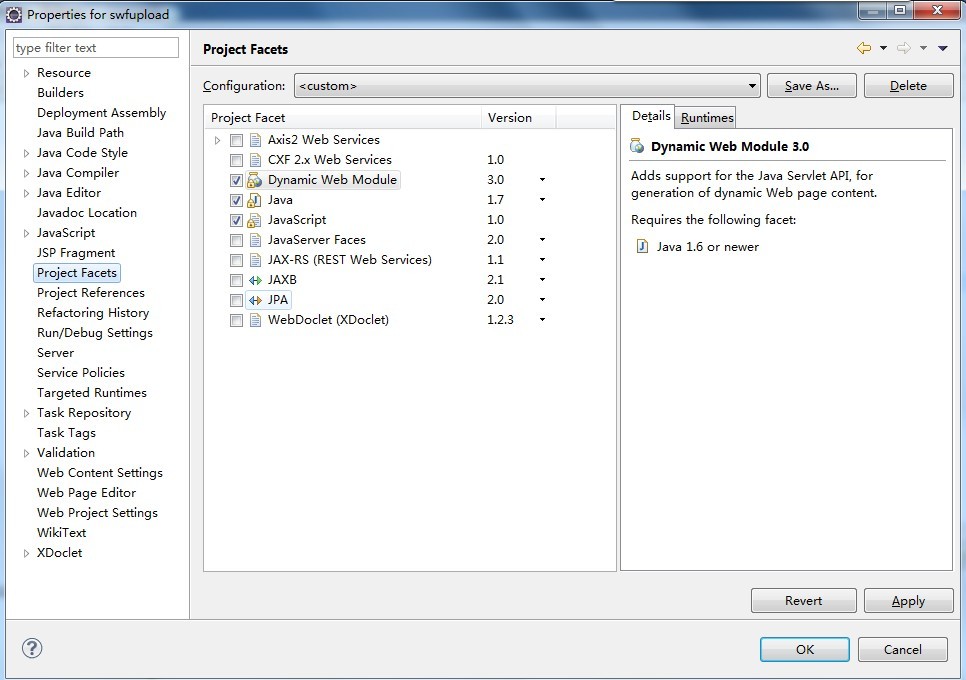- 浏览: 480565 次
- 性别:

- 来自: 沈阳
-

文章分类
- 全部博客 (437)
- Windows设置 (2)
- oracle数据库 (39)
- bug--jsp (4)
- j2se (13)
- js (40)
- bug-tomcat不能启动程序 (1)
- Hibernate (29)
- eclipse (20)
- java (65)
- 设计模式 (6)
- bug (18)
- PL/SQL (11)
- 前台 (5)
- 杂谈 (25)
- UML (1)
- jdbc编程 (2)
- 技术调研 (1)
- 数据通信 (2)
- ios (1)
- servlet自学笔记 (10)
- tomcat (9)
- SQL学习笔记 (6)
- java工具 (1)
- 数据库设计 (4)
- javascript (10)
- jsp (11)
- struts (17)
- ajax (7)
- linix/Unix (6)
- 资源 (3)
- spring (14)
- 算法 (5)
- 计算机网络 (2)
- http (5)
- c++ (2)
- web应用 (3)
- jvm (5)
- java中的字符编码 (14)
- java代码库 (2)
- classloader (1)
- 读书笔记 (1)
- c (1)
- 开源软件 (1)
- svn (1)
- AOP (1)
- java序列化 (1)
- 多线程 (4)
- The legendary programmers (1)
- Apache http Server (1)
- html tag (3)
- struts1.X学习笔记 (5)
- buffalo (1)
- 自己收藏 (0)
- TOEFL(IBT) (1)
- 网络翻墙 (0)
- 编译原理 (1)
- 书籍推荐 (1)
- css (10)
- javaee环境搭建资料 (1)
- 开源工具 (1)
- 美国生活 (1)
- spring自学 (3)
- log4j (3)
- 算法与数据结构 (5)
- 病毒,插件处理大全 (1)
- flex (2)
- webservice (1)
- git (7)
- cs (1)
- html (4)
- javaee (6)
- 开车 (0)
- springmvc (3)
- 互联网架构 (2)
- intellij idea (18)
- maven (15)
- mongodb (2)
- nginx (1)
- react (3)
- java基础例子 (2)
- springboot (2)
- 培训 (5)
- mysql (3)
- 数据库 (3)
- 生活 (2)
- intellij (3)
- linux (2)
- os (3)
最新评论
-
潇洒天涯:
[color=blue][color=cyan] ...
oracle 通过 nvl( )函数sql 查询时为 空值 赋默认值 -
hekai1990:
受教了..
oracle中的varchar2
众所周知,myeclipse自带了很多实用的插件,正因为这些插件的强大功能,帮助web程序猿提高了开发效率,同时也看到了无限明媚的春天!而eclipse给大家的印象则是,绿色软件,体积小,速度快,界面清爽,这些都是它显著的优点,当然,它也有缺点,那就是功能相对myeclipse而言比较少。虽然eclipse也可通过扩展插件来增加很多与myeclipse相同的功能,但很多人习惯了拿来主义,自己去折腾这样或那样的插件总觉得麻烦,还不如直接安装myeclipse,一会功夫,全部搞定,接着便可以大展拳脚,开始自己的宏图大业。不过,我要说的是,那是曾经的eclipse,现在eclipse推出了很多开发版本,无论你是c++,还是java,eclipse都提供了相应的开发版本。比如做java的web开发,eclipse有对应的j2ee版本。当然,萝卜青菜各有所爱,每个人都有它喜欢的IDE,并且每个IDE都有它的优点和缺点。就比如我,我喜欢不耗内存的,界面漂亮的工具,所以eclipse肯定是我的最爱,尤其爱eclipse中代码的字体和颜色搭配得很好,看起来很舒服。当然,还有个客观的原因,那就是开发语言是java,正是因为这个原因,所以当遇到myeclipse的web项目,如果我需要把这个项目直接导入到我的eclipse工作目录中,就需要进行一些配置上的修改,如果不修改,项目将无法直接运行。以下是具体步骤: 1、通过eclipse的import方式,将web项目导入。 2、打开.project文件,将原配置文件中的<buildSpec>...</buildSpec><natures>...</natures>部分替换为以下内容: 3、刷新项目,项目->右键->Properties->Project Facets->Configuration->custom,选择Java和Dynamic Web Module(注意版本,如果无法确定自己的版本,请从高往低测试) 4、修改.settings目录(可在navigator视图下查看)中org.eclipse.wst.common.component文件的如下内容: 5、刷新项目,然后查看classpath是否有问题。 一切大功告成,自此便可以部署和访问了。

改为:
6、最后,删除eclipse默认的WebContent目录,Myeclipse默认的是WebRoot。
发表评论
-
maven项目src源代码下的资源文件不自动复制到classes文件夹的解决方法
2018-07-01 23:34 1144POM文件 <build><resour ... -
eclipse设置jsp模版,默认编码
2017-07-31 16:02 258窗口——>首选项——>Web——>JSP文 ... -
eclipse查看jar包中class的中文注释乱码问题的解决
2017-07-31 15:24 6961,问题来源是在eclipse中直接查看springside ... -
【转】Eclipse导入EPF配置文件
2015-06-01 19:24 984为了美化Eclipse大家可以从 http://www.ec ... -
【转】如何在Eclipse下查看JDK源代码
2013-07-13 11:27 781不会看JDK源代码,相当于没学过Java。 网上不容易 ... -
【转】eclipse 中如何安装插件
2013-05-08 21:53 746^_^ ^_^火来惭愧,用eclipse快两年了都不曾知道如何 ... -
【转】eclipse ide for java ee developers 开发环境搭建(j2ee)
2013-01-26 22:09 3811转载自:http://www.iteye.com/topic ... -
【转】DIY你的Eclipse--打造漂亮代码和完美配色
2013-01-08 21:17 839原文:http://chenchuangfeng.it ... -
Eclipse中的Text File Encoding与文本文件的编码的关系
2012-08-27 17:25 1457当我们编写一个txt文件或jsp页面时,我们用默认的一种编码区 ... -
【转】eclipse常用断点
2012-08-24 16:50 7581、 条件断点 断点大家都比较熟悉,在Eclipse ... -
【转】关于“The type **** is not accessible due to restriction on required library”问题的
2012-05-09 11:10 1156在eclipse里出现“The type **** is ... -
【转】eclipse中的.project 和 .classpath文件的具体作用
2012-03-29 13:36 784.project是项目文件,项目的结构都在其中定义 ... -
【转】关于Java的Classpath详解
2012-03-29 13:19 762Java 的新入门者对classpath往往比较困惑,为何在开 ... -
【转】Eclipse.classpath文件浅谈
2012-03-29 13:17 1341<classpathentry exported ... -
【转】MyEclipse中使用复制粘贴功能卡的解决办法
2012-01-09 14:20 1025最近在MyEclipse中编辑代码时,使用快捷键进行复制粘 ... -
eclipse注释模板
2011-12-15 09:17 1037window - preference - jav ... -
eclipse中的几种view
2011-12-15 09:10 784view中,实心表示方法,空心表示变量;绿的是publi ... -
eclipse快捷键---补充中
2011-12-15 09:04 1257Ctrl+1 快速修复(最经典的快捷键,就不用多说了) ... -
eclipse设置断点,关联不上源文件
2011-11-18 16:35 1875新更新的svn代码,在eclipse里面设置断点,关联 ...






相关推荐
将java项目从myeclipse导入eclipse
myeclipse和eclipse的web项目导入
将MyEclipse项目导入eclipse 将MyEclipse项目导入eclipse
myeclipse项目导入eclipse项目的时候,需要修改的配置
myeclipse项目转换成eclipse,将web工程转化到eclipse下
myeclipse工程转eclipse工程
一个初入it的学者,这些天我开始尝试从myeclipse转为eclipse学习开发web项目,遇到一些小问题。这部分是在网上好不容易找到的。
MyEclipse/Eclipse不编译MyEclipse/Eclipse不编译MyEclipse/Eclipse不编译MyEclipse/Eclipse不编译MyEclipse/Eclipse不编译MyEclipse/Eclipse不编译MyEclipse/Eclipse不编译MyEclipse/Eclipse不编译
从myeclipse导入eclipse导致不能识别为web项目(java项目转为web项目)
将项目导入Myeclipse 如何导入项目源代码 myeclipse
根据文档的描述可以轻松的将MyEclipse下建立的web项目添加到Eclipse开发工具下。
一,用cvs导入项目操作步骤 二,导入项目的错误 三,项目同步
这份文档详细说明了myEclipse/Eclipse中是如何配置java文档注释的,每次在myEclipse/Eclipse中写java代码时就可以用同一的文档注释了,减少了手工注释的麻烦。
自己搜索整理总结的myeclipse导入项目后中文乱码的解决方案
Eclipse导入Myeclipse编写的web项目时,需要进行设置才可以正常使用,进行编译,此文档对此进行了简单的归纳总结!
在myeclipse或eclipse中导入注释文件和格式文件,便于编码规范
myeclipse导入项目.docx
共有四处编码格式,1、workspace即container 2、 *.java源文件的编码格式 3、 项目编码格式 4、 项目中每个.java文件的编码格式
MyEclipse导入现有项目,说明很详细,能够帮助你把从别处来的项目导入到myeclipse中。可以下载!
MyEclipse如何导入现有项目到工作空间教程